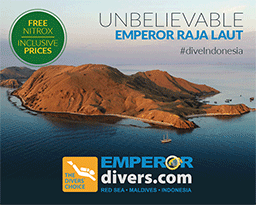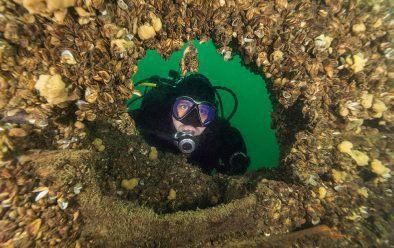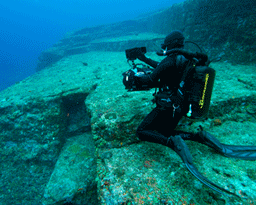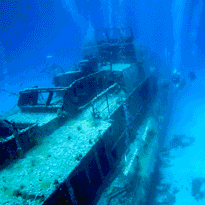
CANADA DIVER
Two Ways to make a Canadian Splash
ALI POSTMA and her husband Joey are working their way around Canada to document the diversity of its diving from coast to coast. She picked out two contrasting locations to give us a flavour…

A spiny lumpsucker.
From the north pacific to the high Arctic to the North Atlantic, Canada is one of the largest countries in the world. Not only are we big, but at more than 150,000 miles we also have the longest coastline in the world, and more freshwater lakes than any other nation.
Water is everywhere. It’s the babbling river flowing through the prairies, the azure lake high in the mountains, the cold ocean that provides fishermen with lobster. Water connects us.
Joey and I have done countless dives all over the world, and it would only seem logical that as Canadians we would have explored our own backyard. But before last year, I could probably count on one hand the different places we had dived in our home country.
We had barely scratched the surface of scuba-diving in Canada.
Our project “Canadian Splash“ was born of our desire to connect and encourage other divers to experience this watery world – we’re in the process of diving and photographing every province and territory in Canada to showcase the beauty, wonder and fragility hidden below the waterline.
To provide a flavour for DIVER, we feature a saltwater and a freshwater location in two provinces.
When considering the coldwater diving possibilities of Canada, where do you even begin? In the Great White North, with its vast expanses of untouched wilderness and icebergs? Or perhaps the Bay of Fundy, where you can slip beneath the surface to sample diving amid the world’s highest tides?
Come hell or high water, the diving doesn’t stop – at least, not in New Brunswick.
Where most people would dismiss the idea of diving in low visibility, ripping tides and unpredictable currents, Joey and I greeted the eastern province’s Bay of Fundy with open arms.
The bay is a world-renowned tourist destination but also a unique diving location. Not everywhere along its coastline screams scuba-diving, but Deer Island near the US border hosts a phenomenal underwater world.
The distribution of islands in the area, the confluence of current and seafloor bathymetry has given rise to the “Old Sow”, the largest tidal whirlpool in the Western Hemisphere, which swirls just off the tip of this Fundy isle.
Given the unforgiving nature of a tidal whirlpool, diving there means embracing strong current and also, of course, timing your dive just right for the slacks that allow for safe enjoyment of this beautiful place.
Appeared in DIVER January 2020
A shiver of cold and dark water surrounds me as I inhale and exhale like Darth Vader through my regulator.
Even with a drysuit on, diving in the Bay of Fundy can feel mighty chilly at any time of year. I’m not alone as I grimace when the Atlantic Ocean floods my neoprene hood, because Joey is also cringing at the cold.
It’s roughly an hour before slack tide. The disturbed waters of the Old Sow have died down, and I deflate my BC, feeling that sense of perfect freedom as the pressure from layers of heavy gear dissipates. The world slows down.
I glimpse the first few spiky green urchins littering the seafloor. We follow their trail deeper.
I can feel the building water pressure and a gentle current carrying me away from my entry point. I make the most of the remaining ambient light.
The sloping seabed gradually turns into a rocky wall jutting out from the floor. Bright pink encrusting algae garnishes every nook, making me feel like Scuba Barbie.
I see marine life everywhere, in reds, pinks, greens, oranges and yellows melted together as on a painter’s palette.
This wall hosts so many macro critters that if you were unwise enough to put down a finger, you would be likely to disturb an anemone or nudibranch.
The fauna of this lesser-known Canadian dive paradise are glorious but not surprising. Twice a day, billions of gallons of cold, nutrient-rich north Atlantic waters are flushed in and out of the bay, bringing with them this diversity of life.
The Old Sow’s current gently pushes us along, like a lazy river ride. While drifting we find and photograph marine life with colours and textures that hardly seem to belong in such an extreme environment.
Further along the wall, I feel the tide methodically change direction, signifying the midway point of our dive.
We retrace our route, moving up the rock wall to scour a shallower section for macro movement.
This is usually the best part of the dive, where we tend to have the most luck finding spiny lumpsuckers – my favourite photographic subjects. I could spend an entire dive focused on these tiny guys.
Joey signals me over, having spotted a pudgy fish anchored by its suction disc on the rock. I’ve seen lumpsuckers on many a dive, but every time I see a new one I squeal into my regulator.
These squishy little fish, sometimes little bigger than a fingernail, have a way of swimming so awkward and adorable that it melts your heart.
We spend more than our share of time playing with the spiny lumpsuckers, and the current starts picking up. The Old Sow whirlpool is starting to go round again. I enjoy Deer Island’s kaleidoscopic views for a few more minutes before slowly surfacing…
When I learnt to dive in my home province of Ontario, it wasn’t because of any particular interest in cold, murky lakes – it was simply because I loved being under water.
So when my Canadian Splash journey brought me home for the summer, I was happy to plan a trip to Ontario and Brockville, land of 1000 islands!
Perched on the St Lawrence River, the city of Brockville is often overlooked as a diving location compared to its Tobermory counterpart. Yet, as the link between the Great Lakes and the Atlantic Ocean, it’s no surprise that the bottom of this seaway is littered with shipwrecks.
As a big wreck-diving enthusiast, I was excited to dive Brockville. What makes St Lawrence diving appealing is not only the warm water and lack of thermocline but also the easy access to the wrecks, sometimes from shore.
On our first dive-day, my two-man buddy team (Joey and my dad André) and I opted for a shore-dive to the Rothesay, a 59m wooden side-wheeler. Built in 1868, she sank after colliding with a tug in 1889.
We prepped for the dive from the back of our vehicle and headed down to the water for final checks before following an underwater line running out to the ship.
After months of diving in the ocean, it was strange not to feel the bitter saltiness of the sea tickling my tongue. This was an environment of freshwater wonder.
Finning through the weedy shallows,
I watched as invasive gobies darted willy-nilly across the sand. I also kept my eyes open for larger predators such as pike, known to hide out in the plant life.
It was about 15 minutes before I saw the stern of the Rothesay materialise out of the murk. A glance at the old wooden riverboat showed that time and water had not been kind to it. That and the demolition training by the Royal Military College in Kingston had done a number on its structure.
But despite the shambles in which the Rothesay had been left, looking closely I could recognise its shape and part of the paddle-wheel. We circled the wreck, looking out for interesting creatures.
Freshwater sponges, mussels, snails and walleye were among the aquatic wildlife we enjoyed in the open, but more elusive fish such as perch were harder to track down. We finned over and under heaps of timber boards and metal rigging fixtures, reminders of the Rothesay in its heyday.
For the following day we had pencilled in the Conestoga, originally a 77m timber passenger / package steam freighter.
Built in 1878, she sank in 1922 after catching fire while traversing the upstream lock. Amid fears that she would burn the lock, she was flushed out into the river and landed in the shallows, where the wreck remains today lying in a mere 9m.
I was a little apprehensive because of the current that could be seen swirling around the rusty engine, which stands above the waterline just offshore. Would I be able to capture compelling images while battling the flow of the river?
We pushed off from the shoreline, emptied our BCs and dropped to the riverbed, where a plaque thoughtfully provides information about the vessel. The further we swam from shore, the more the current picked up.
When the Connie was in our sights we lifted off the bottom, riding the current on the port side. We whizzed past the deck planks and the timber structure of the hull along with a fleeting fish or two and, all too fast, reached the stern.
A large group of walleye were hanging out in the sandy shallows, and as I watched them swim against the current, a grumpy-faced pike darted out of nowhere. It lunged in for the kill, the walleye scattering quickly – too quickly.
I looked at my buddies and had to snicker into my regulator – better luck finding lunch elsewhere, Mr Pike.
After this Blue Planet sideshow, I returned my attention to the rear of the Conestoga, where the massive four-bladed propeller was a sight for sore eyes.
It was far the most interesting part of the ship, so I indulged in some photo opps while my buddies poked around.
Along the starboard side of the wreck we found a long metal chain placed to help divers pull themselves against the current and explore the boat a second and third time. Hand over hand, I turned my mask into the flow and inched my way upriver – a slow, gruelling process.
Back at the bow we went for round two, this time dropping inside the Connie.
The inner hull offered protection from the current and made it much easier to photograph and move around.
I spotted huge chain-links and a large windlass in the hull but, making our way through the zebra mussel-clogged shallows, I also got to see the massive boilers, winches, engine, deck fittings and other miscellaneous artefacts.
The 1863-vintage Robert Gaskin was to be the last stop on our Brockville diving adventure. After repeated sinkings and salvages, her final fate came in 1889.
We joined a local boat charter this time, because the wreck lies slightly out of reach for shore-divers.
After multiple dives in the area, we had our scuba routine down to a tee, and it didn’t take us long to prep for the dive.
We stepped into the water and made sure to grab the anchorline. Down it we went, battling strong surface current that lessened at depth.
Touching down at 18m, we got our first look at the wooden barge. Resting on a firm bottom, the wreck was about 35m long and the hull far more intact than the Rothesay’s had been.
We drifted over the deck, and could see the picturesque wooden railing and large timbers making up the framework.
I love diving shipwrecks, but the Gaskin was an eerie sight against the ghostly green freshwater backdrop. Towards the stern its condition seemed to deteriorate substantially, and I was surprised how few fish could be seen.
The previous two wrecks had been fish magnets – tails and scales had seemed to flutter everywhere.
Back at the bow, by far the most spectacular part of this wreck, we checked out a large hole in the hull and a rusty anchor.
Unlike on the other shallow shipwrecks, our time on the Gaskin had passed far more quickly than we had hoped. Before I knew it, it was time to ascend.
FACTFILE –
Deer Island
GETTING THERE> Deer Island is accessible by half-hourly ferry at L’Etete, near St George. The closest airport is at St John, about 45 minutes’ drive away, and car-hire is essential as there is no public transport to Deer Island.
DIVING> There are no dive centres on the island – the nearest is the Dive Shack in St John, so you might need to stock up with tanks. You will also need local advice on tidal movements.
ACCOMMODATION> Selection of small B&Bs or camping on the island.
WHEN TO GO> Year-round.
PRICES> Return flights via Toronto or Montreal from around £520. A week’s car-hire costs around £200. Tank hire from the Dive Shack costs about Canadian $15 a day or $20 for the weekend.
VISITOR Information> tourismnewbrunswick.ca
FACTFILE –
BROCKVILLE
GETTING THERE>Fly from the UK to Montreal, Ottawa or Toronto. Hire a vehicle at the airport and drive to Brockville – the many shore-diving opportunities require personal transport.
DIVING> Abucs Scuba, divebrockville.com
ACCOMMODATION> Hotels, B&Bs and campsites – Super 8 Brockville, KOA Mallorytown, Happy Green Acres and Lucky Loon Campground are known as scuba-friendly.
WHEN TO GO> Spring or late autumn offer ideal visibility, the summer peak water temperatures.
PRICES> Return flights to Toronto from £280, a week’s car hire £200. Many well-marked shore-diving sites in Brockville and Prescott are free to dive. Centeen Park, an underwater sculpture museum, costs $10. Tank hire starts at $16. Two dives on a charter-boat cost around $90.
VISITOR Information> ontariotravel.net
The post Two Ways to make a Canadian Splash appeared first on Divernet.
Read More Features, North America, Travel, Travel Features Divernet

















